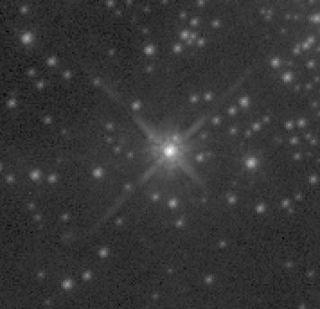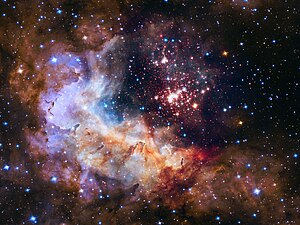
The Arches Cluster is the densest known star cluster in the Milky Way, about 100 light-years from its center in the constellation Sagittarius, 25,000 light-years from Earth. Its discovery was reported by Nagata et al. in 1995, and independently by Cotera et al. in 1996. Due to extremely heavy optical extinction by dust in this region, the cluster is obscured in the visual bands, and is observed in the X-ray, infrared and radio bands. It contains approximately 135 young, very hot stars that are many times larger and more massive than the Sun, plus many thousands of less massive stars.

Westerlund 1 is a compact young super star cluster about 3.8 kpc away from Earth. It is thought to be the most massive young star cluster in the Milky Way, and was discovered by Bengt Westerlund in 1961 but remained largely unstudied for many years due to high interstellar absorption in its direction. In the future, it will probably evolve into a globular cluster.

WR 136 is a Wolf–Rayet star located in the constellation Cygnus. It is in the center of the Crescent Nebula. Its age is estimated to be around 4.7 million years and it is nearing the end of its life. Within a few hundred thousand years, it is expected to explode as a supernova.

R136a1 is one of the most massive and luminous stars known, at 196 M☉ and nearly 4.7 million L☉, and is also one of the hottest, at around 46,000 K. It is a Wolf–Rayet star at the center of R136, the central concentration of stars of the large NGC 2070 open cluster in the Tarantula Nebula in the Large Magellanic Cloud. The cluster can be seen in the far southern celestial hemisphere with binoculars or a small telescope, at magnitude 7.25. R136a1 itself is 100 times fainter than the cluster and can only be resolved using speckle interferometry.

WR 22, also known as V429 Carinae or HR 4188, is an eclipsing binary star system in the constellation Carina. The system contains a Wolf-Rayet (WR) star that is one of the most massive and most luminous stars known, and is also a bright X-ray source due to colliding winds with a less massive O class companion. Its eclipsing nature and apparent magnitude make it very useful for constraining the properties of luminous hydrogen-rich WR stars.
WR 147 is a multiple star system in the constellation of Cygnus. The system is extremely reddened by interstellar extinction – that is, dust in front of the star scatters much of the blue light coming from WR 147, leaving the star appearing reddish.
WR 142 is a Wolf-Rayet star in the constellation Cygnus, an extremely rare star on the WO oxygen sequence. It is a luminous and very hot star, highly evolved and close to exploding as a supernova. It is suspected to be a binary star with a companion orbiting about 1 AU away.

Melnick 34, also called BAT99-116, is a binary Wolf–Rayet star near R136 in the 30 Doradus complex in the Large Magellanic Cloud. Both components are amongst the most massive and most luminous stars known, and the system is the most massive known binary system.

WR 20a is an eclipsing binary star belonging to or recently ejected from the young, massive cluster Westerlund 2. It was discovered in 2004 to be one of the most massive binary systems known, for which the masses of the components have been accurately measured.

CD Crucis, also known as HD 311884, is an eclipsing binary star system in the constellation Crux. It is around 14,000 light years away near the faint open cluster Hogg 15. The binary contains a Wolf–Rayet star and is also known as WR 47.

WR 21a is an eclipsing binary star in the constellation Carina. It includes one of the most massive known stars and is one of the most massive binaries.

WR 30a is a massive spectroscopic binary in the constellation Carina. The primary is an extremely rare star on the WO oxygen sequence and the secondary a massive class O star. It appears near the Carina Nebula but is much further away.
WR 111 is a Wolf-Rayet (WR) star in the constellation Sagittarius. It is magnitude 7.8 and lies about 5,150 light-years away. It is one of the brightest and most closely studied WR stars.
WR 3 is a Wolf-Rayet star located around 9,500 light years away from Earth in the constellation of Cassiopeia.

HD 151932, also known as WR 78, is a Wolf-Rayet star located in the constellation Scorpius, close to the galactic plane. Its distance is around 1,300 parsecs away from the Earth. Despite being a blue-colored Wolf-Rayet star, it is extremely reddened by interstellar extinction, so its apparent magnitude is brighter for longer-wavelength passbands. HD 151932 lies about 22′ west of the open cluster NGC 6231, the center of the OB association Scorpius OB1; it is not clear whether it is a part of the association or not. With an apparent magnitude of about 6.5, it is one of the few Wolf-Rayet stars that can be seen with the naked eye.

HM 1, also known as Havlen-Moffat 1, is an open cluster located in the constellation of Scorpius, close to the galactic plane. It was first observed by R. J. Havlen and A. F. J. Moffat in 1976. HM 1 is thought to be 9,500 to 12,700 light-years away from the Earth, beyond the Carina–Sagittarius Arm. It is heavily reddened by interstellar extinction, so although it comprises mostly blue-colored stars, it appears brighter for longer-wavelength passbands. It is projected against the H II region known as RCW 121, and appears to be the source of ionization for the nearby regions RCW 122 and RCW 123.

HD 152408, also known as WR 79a, is a Wolf-Rayet star located in the constellation Scorpius, close to the galactic plane. Its distance is around 2,020 parsecs away from the Earth.

WR 120 is a binary containing two Wolf-Rayet stars in the constellation of Scutum, around 10,000 light years away. The primary is a hydrogen-free weak-lined WN7 star, the secondary is a hydrogen-free WN3 or 4 star, and the system is a possible member of the cluster Dolidze 33. From our point of view, WR 120 is reddened by 4.82 magnitudes, and it has the variable designation of V462 Scuti.














